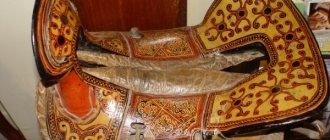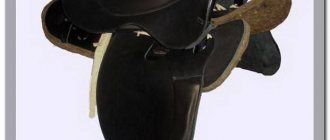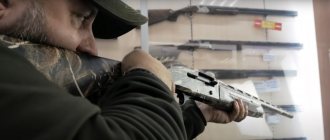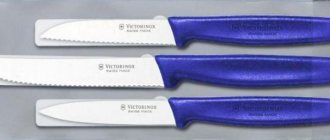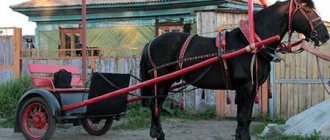The saddle is the most famous element of equestrian equipment. There are many types of saddles, but most of them are obsolete and are only used in various historical reenactments. Sports and dressage options are currently popular. To choose the right saddle for a horse, or to make one yourself, you need to know the features of their design.
What are saddles even for?
Some people believe that saddles are intended only for the comfort of riders, and that they are uncomfortable and burdensome for the horse. Of course, it is much more convenient for a person to use this device for riding. The horse's back is not so level that the eater can sit there comfortably. In addition, stirrups are attached to the saddle, serving as a support for the rider.
How does a horse saddle help the animal and the rider:
- The saddle protects the animal's back from various chafing;
- The design of the saddles helps to evenly distribute the rider’s weight on the horse’s back;
- Pads are placed under the saddle to help protect the horse's back;
- Sitting in a modern saddle, the rider acquires the necessary posture.
Based on the above, it can be understood that a saddled horse is preferable for its owner, and he himself will be better protected from injuries and back abrasions.
Saddling sequence
- Secure the animal in a comfortable position (it is best to place it on the interchange).
- Inspect the horse, clean it (including hooves). Check the harness and place it nearby.
- Standing on the left side, place a saddle cloth (saddle cloth) on your back so that its upper edge reaches half of the withers. Then smoothly lower it just below the edge of the withers. The saddle cloth should lie flat, its edges should be located symmetrically on both sides. In some cases, you can put a pillow (fur or gel) on top.
- Carefully place the assembled saddle on the horse's back just below the withers. Adjust the girth without tightening it too much. Be sure to adjust it before your trip.
- If necessary, attach auxiliary straps to the saddle/girth.
- Put on the bridle. Correct your bangs and mane.
- Fasten the chin strap so that your fist fits freely between it.
After you have properly saddled the horse, you can take it out to the platform or arena, but it is better to leave the stirrups assembled so as not to accidentally get caught on the fence. Before boarding, check and tighten the girth so that your palm fits freely between it and the horse’s body, and adjust the length of the stirrup harnesses to the desired length.
Types of horse saddles
Currently, saddles come in different types:
- Asian;
- Ladies';
- Cossacks;
- English;
- Spanish and so on.
It is very rare to find such specific types as the Western or Indian type saddle. Most modern models of this type can only be found at various shows or historical reconstructions. Despite this, modern and historical versions have much in common:
- They all have a fore and aft pommel;
- Wing and fender liner;
- cinch;
- sweatshirt;
- Tightened;
- Schneller;
- Pillows;
- Harness straps;
- Stirrups.
Some specific models, for example, the women's saddle, had a non-standard design.
The design of the sports version of the saddle
Saddle for equestrian training in dressage and jumping arenas
Each sports saddle consists of:
- Fore pommel;
- Seats;
- Rear pommel;
- Pillows;
- Belt loops to tuck in the end of the belt;
- Rear airbag on the wing;
- Wing;
- Front wing airbag;
- Rings for fastening the underarms;
- Schneller (lock for securing the harness).
Sports saddles can have a combined (wooden and metal) or plastic tree. Sports saddle cushions are stuffed with wool or modern soft polymer materials.
Features of cavalry and Cossack saddles
A cavalry saddle is a convenient element of horse harness, designed for the rider to remain in it for a long time. A special feature of cavalry saddles is the material from which the tree is made. As a rule, it was wood or steel. Since this type of harness was used in the army, it was often equipped with various devices for attaching luggage and weapons.
The Cossack saddle differed from the cavalry type in a more traditional shape for eastern models. The rider sits significantly higher than in European types of saddles. In addition, Cossack models have special handles, which are located on the front and rear bows. Once upon a time, these handles were used as weapon mounts. Now these handles are used, as a rule, as support points during horse riding. A sweat cloth is placed under the Cossack saddle; the blanket has never been used.
What does a horse saddle consist of?
There are many types of saddles, but their design scheme is approximately the same.
The most common seat consists of:
- a wooden, plastic or metal tree base, which includes two bench parts connected at the front and back using arched bows;
- two leather wings, which are needed to prevent the rider’s legs from contacting the buckles on the harnesses and harnesses;
- two leather fender liners;
- leather seat, allowing the rider to take a comfortable position;
- two pillows made of thick material, which are stuffed with wool and are located under the seat to minimize the effect of the rider’s weight on the animal’s spine;
- a felt saddle pad, which softens the pressure of the seat and pillow on the horse’s back and prevents abrasions from forming;
- a braid, rubberized or leather girth, which should fit tightly around the horse’s body and prevent the seat from sliding to the side or along the back;
- two or four girths to which the girth is attached;
- two stirrups made of leather and metal and two harness belts.
This structure has a standard seat, and depending on different types, some of its components may vary.
Let's look at what types of saddles there are.
The main purpose is to travel long distances, often used for hiking or hunting. Characterized by the presence of a soft seat.
Thanks to the wide shelves, the horse can move freely, and they do not put pressure on his back, since the rider’s weight is distributed evenly. The seat is equipped with additional rings to which you can attach equipment.
Dressage
A distinctive feature is the deep seating, thanks to which a person can straighten his legs. It has a short seat, narrow and long wings.
Universal sports
By the name of this seat, you can guess its purpose. It has a universal shape, used in all types of equestrian sports.
It is used for show jumping and has some differences from a regular saddle: the wings can protrude forward, the pommel has a round or square shape.
Eventing
In appearance it is very similar to a universal one; it can be used for different purposes. However, there is one difference - the airbag and wing are slightly moved forward, which makes it possible to change the landing to a field position during the cross-country.
The main purpose is horse racing. It has a simple shape, a flat seat, and a short waist. Many people are interested in the question of how much this ammunition weighs. Its weight is very small - only 400 grams. This species is easily confused with the treeless species.
Cavalry (racing)
The main purpose is for a person to remain on a horse for a long time. To make the saddle tree, durable materials (steel or wood) are used, which has a beneficial effect on wear resistance.
Thanks to these materials, the load on the horse's back is properly distributed. Previously, such ammunition was used in the army and long campaigns, so it has additional fastening components for weapons.
The design of this saddle was developed taking into account the wishes of rangers and hunters. Thanks to its design, the correct position of the rider is maintained and does not hinder the movement of the animal.
It belongs to the traveling type of saddles, but a different technology was used for its manufacture. The main elements are wings, pillow and archak. The seat has a small shape and a handle - thus, a person can rise up and perform horse riding.
Officer's (Warsaw)
Most often, such a seat is found at military events, parades, and is worn on mounted police animals. It has many mounts for various weapons and other things.
Western (cowboy)
Previously, it was used by American cowboys to herd cattle. It has a slightly different shape from a standard saddle, thanks to which a person can sit comfortably and comfortably in it and feel confident even with unexpected movements and the horse stopping. The Western has an ideal pattern and makes it easy for the horse to move around.
A specialized type of saddle that is designed for the purpose of carrying heavy and large loads on a horse.
Feminine (ladies)
People first learned about the side saddle back in the 7th century. At this time, women wore full skirts; it was very uncomfortable to sit in a man's saddle in them, so equipment was developed specifically for the weaker sex.
However, as soon as trousers entered women's fashion, such saddles ceased to be popular. But recently they are becoming in demand again. All of the above types, with the exception of the Western saddle, belong to the “English saddle” group.
Ladies' saddle and its features
The first ladies' saddle appeared in Ancient Greece. On ancient frescoes you can find images that vaguely resemble modern models. The main feature of modern ladies' saddles is the presence of two bows. This allows the rider who sits sideways to feel more confident on the horse's back. Despite its “feminine” purpose, the side saddle is a very dangerous invention. However, in the past, ladies could not only jump quickly in it, but also take on various obstacles.
It is especially worth noting that an old ladies' saddle weighs about 12 kg, which made horseback riding a problematic activity for a single lady. As a rule, ladies with horses were helped by servants or relatives, and the most noble persons had special grooms, who often not only accompanied the mistress, but also led her horse by the bridle.
Modern models of ladies' saddles are made from lightweight materials, which makes them not only more affordable, but also more than twice as light. The design of a modern saddle allows the rider to feel more comfortable and confident.
Modern lady riding
If earlier side-saddle riding was a tribute to fashion and tradition, today it is a hobby, and people not only ride horses in this discipline, but also hold various competitions. Ladies' riding allows you to perform various actions: go hunting, jump over barriers, compete in almost the same disciplines as in ordinary sports.
Ladies' riding allows you to compete in almost all equestrian disciplines
In England and Germany there are many different classes for ladies' riding. This includes show jumping and dressage of different levels, riding in historical costumes, and there are even special classes for small children on ponies in small side saddles.
Even children ride side saddle
Sports saddles for equestrian sports
Saddles for equestrian competitions can be divided into the following types:
- Dressage saddle. This type is specifically designed for equestrian dressage. The rider's seat is very deep, since the horse must feel the slightest changes in the person's posture and understand all his commands, which are given by the body and legs. Dressage-style saddles have short seats and narrow shelves;
- Universal type sports saddle. This type is suitable mainly for amateurs who do not seek professional participation in competitions. Due to their convenience, saddles of this type can be used for walking, hunting and various training sessions;
- Saddle for eventing. This model is very similar to the universal one, but has a wing extended forward. This provides convenience when making field landings during cross-country;
- A racing saddle is characterized by minimal weight, since every extra kilogram plays a role in racing. The stirrups of this type are short, since the rider stands in them during competitions.
For those who do not intend to engage in professional equestrian sports, it is better to purchase universal saddles.
Popular types of saddles
- Dressage saddle for a horse: these saddles have deep seats with straight wings, which allows riders to ride with longer stirrups for better leg contact with the horses' sides;
- Jumping saddle for a horse: they have longer and flatter trees, shorter and more forward wings to help riders maintain the desired position, namely, to move the body forward;
- Eventing saddle for a horse: very similar to showjumping saddles, but their wings are moved forward even more, and the leg rests become more pronounced. This may be required for field plantings;
- Racing saddle for a horse: they are even more suitable for riding. In this case, the knees rest against the wings with shortened stirrups. They are extremely lightweight, it is simply impossible to confuse them with other types of saddles;
- Training saddle for a horse: designed for use in rental groups and for training novice riders. Training saddles are made on the basis of jumping trees with slightly straighter (without stems) wings and without benfutors. These saddles are made from genuine leather;
- Universal saddle for a horse: universal saddles, unlike jumping saddles, have a slightly less forward wing extension. Universal sports saddles, like training saddles, are almost the same; some experts classify them as hybrids of jumping and dressage saddles.
There are also some types of saddles that are quite specific and are distributed exclusively in a certain area.
Fully equipped officer's saddle for hunting
These can be called:
- Cavalry saddle;
- Cossack saddle;
- Officer;
- Farm;
According to the old tradition, horse saddles, like bridles, are made of leather, however, nowadays you can increasingly come across cheaper synthetic materials.
Features of saddle selection
Not only the comfort of the rider depends on the right choice of saddle. This directly affects the relationship between animals and humans. If the saddle gives the horse unpleasant sensations, then he will never have an understanding with the rider, so the saddle must be tried on. In this case, you need to pay attention to the following points:
- The uniformity of the saddle on the horse’s back;
- Check whether the structure is pressing on any side;
- The saddle should not move forward or backward.
If everything is in order, you need to tighten the girths and take a test ride. In this case, pay attention to the following nuances:
- The rider's seat should be comfortable;
- When trotting, you must make sure that there is no hair on the saddle pad. The saddle pad itself should not protrude from under the saddle.
If the horse has a non-standard build, for example, has a wide chest, then the issue of selecting a saddle may drag on for several years. It will be easier to find a good saddler who will measure your horse and make a custom-made saddle.
How to saddle a horse correctly
11.08.2013
Tips for horse lovers
A horse kept in a stable and forced to work for hire usually has its own saddle. A beginner rider will most likely be offered a training saddle or a universal sports saddle. The only difference is that the drill does not contain parts adjacent to the withers and spine, which lightens the load on the back and makes saddling somewhat easier. The process of putting on a saddle is not at all complicated, but as in any business, it has its own rules and subtleties.
Before saddling, the horse should be cleaned from nose to tail. The question of what to put on first, a bridle or a saddle, is asked by all beginning riders. The answer is: if the horse is standing at the turnout, then it is more convenient to saddle it first and then deal with the bridle. If saddling takes place in a stall, then first bridle, and then put on the saddle. Before the lesson, the trainer must check the condition of the horse’s withers and back. And only after the horse is “cleared” for training, proceed to saddling.
Stages of saddling a horse
- Run your hand from the withers to the lower back to make sure that on the back, where the saddle will lie, there are no unevenness and roughness, specks, etc., which can lead to sores, chafing and injuries. You should also check the area where the girths will be for dirt or matted fur.
- Take a saddle pad, it must be clean, even a small speck on the inside of the saddle pad can rub the skin of the back until it bleeds, which can consequently incapacitate the horse. Therefore, inspect the saddle pad thoroughly before placing it on your horse's back. Some clubs (especially those supporting the Western movement) may offer a thin blanket folded in half instead of a saddle pad; it must also be absolutely clean and free of wrinkles. A saddle pad or blanket serves as a lining under the saddle, absorbs sweat; only in some cases, horsemen put several saddle pads in order to adjust a too wide saddle to a narrow back. Place the saddle pad on the withers and move it slightly back. Under no circumstances do it the other way around (in front), that is, against the grain.
- The saddle is taken on the left hand, the horse should be approached strictly from the left. The stirrups must be pulled up, that is, raised along the internal strap of the harness (the belt on which the stirrup is suspended from the saddle) upward, and the free loops of the harnesses themselves are threaded into the stirrups. The girths are assembled and lie on the saddle. The sweatshirt (usually tucked into the saddle) should be straightened.
- The saddle is placed closer to the withers, and, like a saddle pad, moves slightly backwards. If the saddle does not fit the first time, repeat the process again. Transfer the saddle to your hand, adjust the saddle pad, checking the horse's back for irregularities, and again place the saddle from the withers, smoothly adjusting it towards the croup.
- Check the saddle pad on both sides; it should not bend under the saddle. The sweatshirt and saddle pad should be evenly visible from under the saddle from all sides.
- The next step is the girths. There may be two of them, or there may be one wide one, but with two buckles. The girths are lowered to the right side of the horse and straightened if they are twisted. Having straightened it, go to the left side and pull the first (closest to the front legs) girth towards you. If a martingale is used, then the lower loop of the bib passes through this girth and only after that it is attached to the first girth, gradually tightening it. The distance between the girth and the front legs should be approximately the size of your palm. The second girth (if there is one) is overlapped or at a very short distance, parallel to the first. Tightening the girths occurs in several stages. You will probably encounter cunning and protest from a horse that does not want to saddle; it will simply inflate its belly and you will not be able to fasten the girth even to the first hole on the girth. Very often, grooms act cruelly; they hit the horse under the belly with their knee and it “deflates.” Do not do that! Give the horse a piece of carrot or apple, he will start chewing and his stomach will deflate on its own. After the horse's girths are tightened, make sure that he does not lower his head. This poses a risk of injury called “pinching.” Remember that you should not leave a saddled horse alone in the stall, other than lowering its head, it can lie down and seriously injure its back and ribs. It’s easy for an unattended horse to get caught in a stirrup (even if correctly assembled on the saddle), get scared, jerk and get hurt.
Cossack, vaulting, Spanish, and even jumping saddles have their own characteristics. Be sure to get a few saddle classes before you saddle yourself. It is better if at first someone helps you, at least to calm the horse and give the girths.
Stages of making a saddle
If you want to make a saddle yourself, then you should not hope that it will work out the first time. Saddlery, like many other things, requires perseverance. Those who are not afraid of difficulties need to know that any saddle is made in several stages:
- First, a tree is made, which is the basis of the entire structure. The comfort of the horse depends on the correct production of the tree. The base of the structure is made of wooden planks, which are connected to each other by metal decks. Before you start work, you need to make a mock-up of the product using cardboard and wire;
- After making the tree, you need to stuff the inner upholstery. To do this, a base is made of plywood, on which a foam upholstery is applied. Most often, foam rubber is folded several times. When stuffing foam rubber onto a plywood base, you need to make sure that the nails go into the base of the tree;
- The next step is the production of outer upholstery. As a rule, genuine leather is used for this. Since working with leather requires certain skills, you can use any thick fabric made from natural materials instead;
- After making the saddle, you need to make girths. They are located asymmetrically. The main task of girths is to fix the saddle in one position.
Naturally, this information will not be enough to make a saddle yourself, but it will help you understand the design of saddles.
What position in the saddle is considered correct?
Often, beginners copy the classic position in the saddle and inevitably make a mistake. Their movements become tense and constrained. There is no standard for riding position as such, since people vary in body type. A slouched person will not be able to fully straighten his back, and a short person will look different in the saddle than a long-legged person. But whatever the figure and constitution of the rider, the main thing is that the position does not tire him, but contributes to comfortable control of the horse. The rider sits naturally and beautifully if he follows three key rules:
- firmly maintains balance and freely changes poses when changing moves;
- his muscles are relaxed;
- When riding, it moves in time with the horse.
How to Assess Saddle Wear
Many novice riders who decide to purchase their own horse are faced with the need to purchase a saddle. Since new products are quite expensive, you often have to choose used products. When choosing, you should pay attention to the following nuances:
- The first thing to check is the harness. They may be stretched or thinned. Since the harnesses can be replaced without any problems, you should not give up the saddle, especially if it is in excellent condition, but the price can be significantly reduced;
- All rivets and locks must be in place and working properly;
- Next you need to check the tree. It must not be deformed or broken. You should immediately refuse to buy a saddle with a broken tree;
- The next step is to inspect the saddle pads. They should not be deformed. If necessary, the saddle pad padding can be replaced.
In addition, the appearance of the saddle should not show any visible signs of wear. Abrasions are allowed, but you should not take a saddle with torn leather.
There are a great many options for saddles. The main thing when choosing is to focus not on appearance, but on convenience for both the rider and the horse.
Recommendations for selection
Before you buy or ride a horse, you need to choose the right one. A horse breeder who knows his animals well can handle this better. He can recommend a young horse. However, for beginners in horse riding, it is better to choose an individual in the prime of life, that is, at the age of 8–10 years. Such a horse will know the commands, walk calmly in the harness and, perhaps, even help the new owner.
Of course, first of all, it must be a strong and healthy animal with sufficient strength and endurance. Wise horse breeders recommend local breeds to beginners.
And also the horse must suit the owner in behavior and character. This is another plus in choosing a mature individual, since a young one is not always easy to deal with.
An important factor is the appropriate size of the horse. It should easily support the weight of the rider. And it is convenient for a person to sit on it.
The horse's back should not arch too much. This means that the rider's weight is too much for her. And the animal will not be able to travel for a long time. In addition, excessive heaviness can lead to curvature of the animal’s spine and disease.
The horse must be in good physical shape - moderately well-fed, the hind legs should be located under the rear of the body, but not stick out backwards.
How to learn to balance?
The rider influences the horse not only with the reins and legs, but also with the body. Therefore, it is important that the fit is firm, flexible and relaxed. To achieve a natural posture, beginners initially learn to balance on a horse by controlling their core and lower back musculature. As for the arms and legs, the limbs do not play a role in maintaining balance. It is only when there is a threat of falling to the ground that the rider grabs onto the horse with anything he can. More important is the position of the body in the saddle, where the center of gravity is at the deepest point in the middle of the saddle. In defective equipment, this point is often shifted either forward or backward.
It is better to learn to balance when riding at a walk, after which you can switch to a calm trot. The skill is developed quickly on a calm, broken horse. For greater confidence and safety, it is better to use stirrups. After a few lessons, you can gradually switch to riding without supporting your feet.
Over time, the rider will not be afraid to turn in the saddle and even perform a simple set of exercises - raise his hands up, reach for them and look up, then sharply lower his hands and look down. Gymnastics to develop the skill of balancing in the saddle are performed with stirrups thrown, very smoothly and with maximum amplitude. The set of exercises includes:
Landing is considered incorrect:
"Improper position in the saddle"
How to make it yourself
The structure of a saddle for a horse will not be clear to everyone and making it with your own hands is not easy. To do this, it is recommended to prepare a large amount of material that is resistant to wear, and then begin manufacturing.
What elements does it consist of?
Main parts of the saddle:
- The tree is the skeleton of the structure. It is made of 2 pieces of plywood, which are fastened together at the ends with metal arms. Often the tree is made of durable but flexible plastic. The type of equipment depends on the type of this element. The remaining parts are attached to the frame.
- Fenders and fenders are needed to protect the rider's legs from contact with the girth and buckles.
- Pillows made of dense material, stuffed with wool or synthetic fiber. They are located under the seat and are designed to ensure that the saddle does not touch the horse's spine.
- The harness is a strap under the wing.
- Bows are curved protrusions located in front or behind the saddle. They have different shapes depending on the type of equipment.
- A girth is a strap that goes under the animal's belly. Attaches to the harness and secures the harness, preventing it from slipping. You need to position the girth like this: measure 5 cm from the horse’s front leg and tighten the belt so that your palm passes under it.
- A martingale is a leather strap that prevents a horse from raising its head above the required level. It is located between the horse's legs and attached to the girth and headband.
- Stirrups are metal devices designed to support the rider’s legs when sitting and moving. They are located on the straps on both sides of the saddle.
- Slings - straps, fastenings for stirrups.
- The bolster is an element that prevents the seat from sliding back when climbing.
- A saddle pad is a bedding under the saddle.
Manufacturing sequence
Necessary materials:
- cardboard;
- scissors;
- nails and staples;
- hammer;
- jigsaw;
- foam;
- leather or high-quality substitute;
- leather belts.
The first stage of production is measurements for the frame, which are transferred to cardboard and cut out. Paper blanks are needed to make a wooden base.
Shelves are cut out of plywood, fastened with wire, and a tree. The tree must be sanded and fastened with nails to the shelves. Drill a hole in the shelves for the girth.
Foam rubber serves as upholstery, is cut to the shape of the seat and attached to the body. It is recommended to buy girths, martingales and girths in a specialized store. Then the frame is covered with leather or substitute. Stirrups are attached.
Additionally, you can sew a horse saddle cover for storage.
Small of the back
While your mother may have tried to correct your slouch by slapping you between your shoulder blades, this, along with the myth that Spanish riding school riders trained with planks sewn into their jackets, is a rather naive idea of how to improve your posture. For both men and women, good posture means that the spine rises comfortably and evenly from the pelvis and sacrum upward.
It is impossible to ride well without proper posture. In order to “accompany the horse's movements,” the rider's lower back must be able to move through a maximum range of motion from arched to slightly arched.
The connection of the pelvis to the spine also varies greatly between the sexes. The differences start in the funky triangular bone called the sacrum. Anatomically, the sacrum acts like a bridge. This bone connects the lower spine to the pelvis and legs. The shape and movement of this bone differ greatly between the sexes. Because the lumbar spine "rests" on the sacrum, differences in its shape and position dictate differences in the design of the entire lower back.
Most men have a long and curved sacrum. It blocks the birth canal, which is not a problem for men. However, thanks to this shape, a man can sit on his tailbone, which is completely impossible for women.
Another difference is that in men, the sacrum attaches to the pelvis more vertically than in women, so in a relaxed position, men arch their lower back less than women. For these two reasons, even in profile, a thin woman’s buttocks look more rounded, while a man’s buttocks look flatter, since the anatomically male pelvis is “subducted” under itself.
For riders and trainers, knowledge of these differences in the structure of the sacrum and lower back is even more important than knowledge of the differences in the structure of the pelvis and hips. Due to the pointed structure of the sacrum, women bend more in the lower back. In addition to this, when a woman sits "relaxed" in the saddle, her hip joint lies under or even behind her spine. If you give free rein to the force of gravity, then her pelvis will rotate forward, and her lower back will bend even more.
In men, because the hip joint is located in front of the axis of the spine, when they relax, the pelvis rotates back, gravity pulls the tailbone down and, due to the rotation of the pelvis, the pubic bone rises.
Rice. 10. In this photo I am sitting on my horse named Painty, enjoying a relaxed ride. We work at a slow, relaxed, collected canter. Painty doesn't resist. This is noticeable by the way he holds his ears in the shape of the letter V. At the same time, he makes a significant effort, which can be seen in the concentration in his eyes and in the long, elongated lip, which in horse language means: “I’m trying very hard.” ! I'm just as relaxed as Painty. This photo was taken when I was 46 and Painty was 22. Believe it or not, I'm not trying to put my heels down. They went down on their own thanks to the position of the lower body. My entire lower part from the waist down is relaxed. This photo shows how much Sally Swift's instructions helped me. I no longer have any problems with relaxing my lower back or “accompanying the horse’s movements.”
Rice. 11. Women often say that they like to ride bareback. The fact is that most saddles currently are not designed for the female anatomy and do not allow them to solve the problem of groin position. The horse's back has a completely different shape. In most horses, the low point of the back is behind the withers, and the armpits are usually where the leg naturally rests. These grooves are in front of, not behind or below, the female hip joint. Both of these factors help position the front of the pelvis higher, reduce strain on the hips and lower back, and help the woman relax and straighten her lower spine.
Rice. 12. A thin girl with a long lower back is more likely to sit on her back pockets. At the same time, this girl’s “relaxed stance” is still strikingly different from a man’s due to anatomical differences.
Structural differences
In the musical My Fair Lady, Professor Higgins asks the rhetorical question, “Why can’t women be like men?” In the field of equestrianism, the answer is not rhetorical, but practical: a woman cannot ride like a man because of the structure of the lower back, pelvis and hips - the very parts that are critical to successful horsemanship. Anatomical differences dictate slightly different approaches to things like body half-halts and training trot. They also cause men and women to have different physical difficulties when learning to ride.
Rice. 3. Look how different the ischial bones of the female pelvis are from the male ones. The edge of the female sacrum (coccyx) is turned back. The lower part of the female coccyx goes down more sharply. Thus, the male coccyx blocks the birth canal much more than the female. Also note how much wider the woman's hip joints are.
The Basics of Proper Fit
“Correct seating in the saddle”
The position of the rider on the horse depends on the gait he has set. However, there are principles that govern general planting. To maintain a natural posture in the saddle you must:
